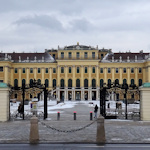
Although Schönbrunn Palace is now thoroughly embedded within urban Vienna, it actually served as a country retreat for much of its life.
- Book a guided tour or other Schönbrunn experience*
- See also:
The Katterburg
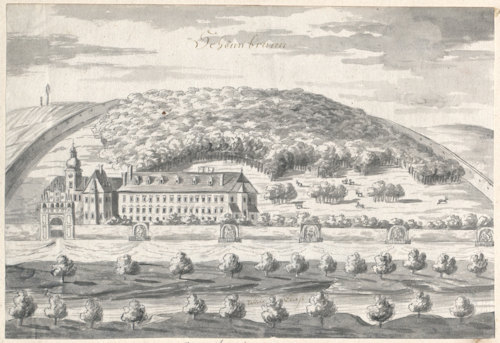
(1619 picture of Schönbrunn. Photo courtesy of the Österreichische Nationalbibliothek – Austrian National Library)
In the mid-13th century, the land in and around Schönbrunn — the present day district of Hietzing — all belonged to the Klosterneuburg Abbey (which still exists and makes a nice trip; Klosterneuburg is an upmarket town along the Danube river slightly west of Vienna).
This area featured vineyards and a small village untroubled by urban development. The Katterburg — a small castle estate with its own mill — stood on the part now occupied by the palace grounds.
Emperor Maximilian II bought the holding from the monastery in 1569, and the land stayed in the hands of the Habsburgs until the end of the monarchy in 1918.
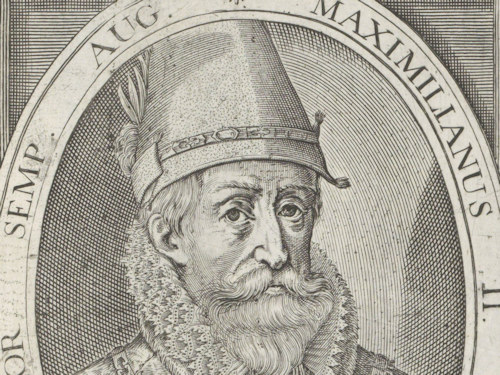
(Portrait of Maximilian II printed in the early 1650s)
Maximilian turned the Katterburg into his own hunting estate, but included fish ponds and collections of some exotic birds. Thus began a tradition which would eventually lead to the establishment of the world’s oldest public zoo.
His successors did little with the place until it attracted the special interest of the second wife of Emperor Ferdinand II, Eleonore of Gonzaga.
After her husband’s death in 1637, the now stepmother to the current emperor (Ferdinand III) retired to the Katterburg to live. In 1642, she had a new hunting lodge built for her.
This is when the Katterburg formally became known as Schönbrunn.
A name change
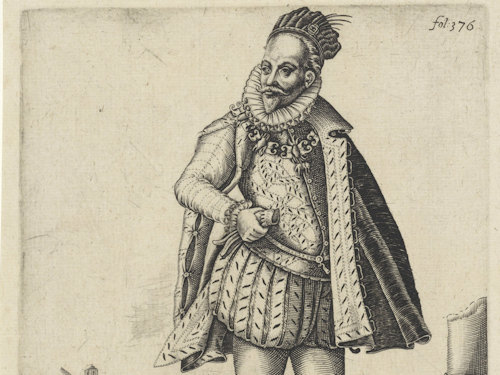
(Emperor Matthias, who inadvertently gave Schönbrunn its name. Photo courtesy of the Rijksmuseum)
The story goes that the name reflects the exclamation made by Emperor Matthias on discovering a spring in the grounds of the estate earlier that century; “Ei, welch’ schöner Brunn’!” translates literally as , “Oh, what a pretty spring!”
The new building picked a bad century to go up, though. Vienna had narrowly survived a first Turkish invasion in 1529 and the Turks returned in 1683 to lay siege to the city once again.
Those behind the city walls held out until rescued by an army led by the Polish king, Jan III Sobieski. Those outside the walls weren’t so lucky; Schönbrunn was destroyed.
Schönbrunn’s rebirth began in 1696 when construction work started on a brand new palace (really a hunting lodge).
(Find tickets and experience options for the palace and zoo)
The Baroque architect responsible was Johann Fischer von Erlach. He’d had a first set of somewhat over-ambitious plans “rejected” a few years earlier, but won approval and — more importantly — the commission from Emperor Leopold for a second set of suggestions.
Fischer von Erlach was one of the great architects of his time, responsible for other great Viennese buildings like the Karlskirche, Palais Schwarzenberg and the Winter Stables for the Spanish Riding School (though his son often completed the actual construction work).
Alas, Fischer von Erlach’s plans never reached full fruition.
The hapless Charles II, King of Spain, inconveniently died childless in 1700, leaving the French, his Habsburg relatives and various other European powers to squabble over the throne.
The War of the Spanish Succession messed up Emperor Leopold’s financial planning and called a halt to construction work at Schönbrunn.
The influence of Maria Theresa
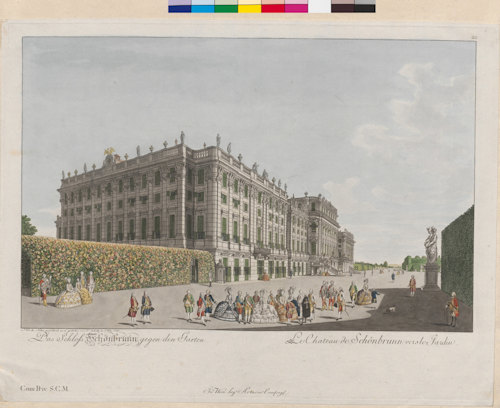
(1782 picture of Schönbrunn (note the colour). Photo courtesy of the Österreichische Nationalbibliothek – Austrian National Library)
The palace achieved its full glory some 40-50 years later, thanks to the drive of Empress Maria Theresa.
Until the Empress’s reign (which began in 1740), Schönbrunn had always been an occasional summer retreat or dowager residence.
Court activities reported in the Wiener Zeitung paper in 1703, for example, talk of the imperial family dropping into Schönbrunn for lunch and an afternoon boar hunt before returning to their city residence.
Maria Theresa, however, turned the location into her preferred full-time summer residence.

(Schönbrunn around 1822, painted by Franz Jaschke; Wien Museum Inv.-Nr. 213463; excerpt reproduced under the terms of the CC BY 4.0 license; photo by the Wien Museum)
So from 1742 until the late 1770s, the palace and its interiors were expanded and transformed into their current complete form.
Despite the delay in completing the work, the architects relied heavily on Fischer von Erlach’s original designs (the architect himself had died in 1723).
Nikolaus Pacassi, the court architect who managed the building works for the Empress, modified and expanded the plans. As a result, both Fischer von Erlach and Pacassi get joint credit for the palace.
By the late 1700s, Schönbrunn stood pretty much as it does today. The only major exterior change was to the façade, which gained its distinctive yellow coloring sometime later.
Modern history
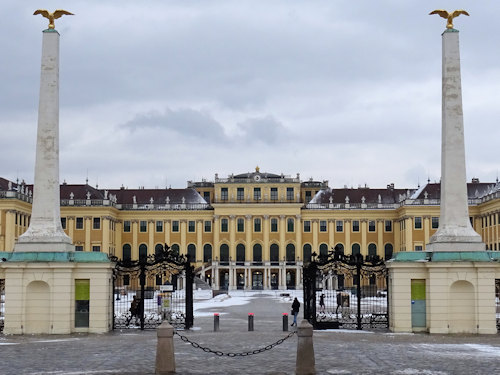
(Schönbrunn palace today)
Most of the later work went on inside the palace, with extensive refurbishments and changes accompanying, for example, the accession of Emperor Franz Joseph in 1848 and his subsequent marriage to Elisabeth in 1854.
The imperial couple were the only royals after Maria Theresa to make Schönbrunn their preferred summer residence (though Elisabeth spent much of her time away from Vienna and the constraints of court life).
After the demise of the monarchy following WWI, Schönbrunn passed into state ownership. It’s now managed by a limited company, though one wholly owned by the Republic of Austria.
In 1996, UNESCO added the palace and gardens to their World Heritage List, stating that the site is of…
…outstanding universal value being an especially well-preserved example of the Baroque princely residential ensemble, which constitutes an outstanding example of a Gesamtkunstwerk.